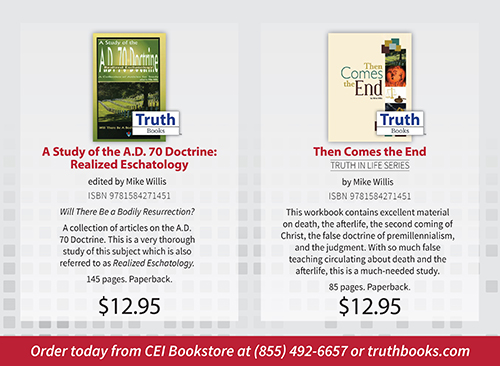

by Kyle Pope
Synopsis: The destruction of Jerusalem in AD 70 was a momentous event, but some have built a misguided theology around this date, and thus distort the plain teaching of the biblical text.
Preterists, who advocate the so-called “AD 70 Doctrine,” argue that Mosaic Law continued after Jesus’ death for Jews until it was finally brought to an end at the destruction of Jerusalem in AD 70. A passage they often cite in defense of their view is the phrase in Hebrews 8:13 that refers to the Law as “ready to vanish away.” Interpreting this as if it is saying, “It was still in force, but ready to end,” ignores the context and seriously misinterprets the force of the passage. The Hebrew writer has just quoted the great promise of Jeremiah 31:31-34 of the coming of and conditions under the “New Covenant” (Heb. 8:8-12). He then refers to what he has just quoted, pointing out, “In that He says, ‘A new covenant,’ He has made the first obsolete. Now what is becoming obsolete and growing old is ready to vanish away” (Heb. 8:13, NKJV). The writer is addressing what “He” (i.e., God) said through Jeremiah. When God spoke these words to Jeremiah, the Law was still in force. The Hebrew writer was describing conditions when God spoke to Jeremiah, not conditions in the first century. In Jeremiah’s time it was “ready to vanish away,” but when the Hebrew writer wrote, it had already vanished away. This is clear from what is taught throughout the rest of the book.
For example, in the previous chapter, he taught, “For the priesthood being changed, of necessity there is also a change of the law” (Heb. 7:12). Three chapters earlier, he said, “Seeing then that we have a great High Priest who has passed through the heavens, Jesus the Son of God, let us hold fast our confession. For we do not have a High Priest who cannot sympathize with our weaknesses, but was in all points tempted as we are, yet without sin” (Heb. 4:14-15). We should note that these were Jewish Christians, yet he identifies Christ as their High Priest. If the Law was still in force, did they have two High Priests? No. So, either the Law had changed, or Christ was not High Priest—but the Hebrew writer clearly says, “We have a great High Priest” (emphasis mine). He does not say we will have (in AD 70). He says, “We have a [singular] great High Priest” (emphasis mine). That means the Law had changed and was no longer in force.
Furthermore, he taught, “For the law, having a shadow of the good things to come, and not the very image of the things, can never with these same sacrifices, which they offer continually year by year, make those who approach perfect” (Heb. 10:1). If the Law was still in force, it taught that those who offered sacrifices “shall be forgiven” (Lev. 4:20, 26, 31, 35; 5:10, 13, 16, 18; 6:7; 19:22). In contrast, the Gospel taught, “In those sacrifices there is a reminder of sins every year” (Heb. 10:3). Christ became “the Mediator of the new covenant, by means of death, for the redemption of the transgressions under the first covenant” (Heb. 9:15). The fact that Christ had become Mediator and Sacrifice made the old sacrifices imperfect and useless. He explains, “For the law made nothing perfect; on the other hand, there is the bringing in of a better hope, through which we draw near to God” (Heb. 7:19). If the Law was still in force, the “better hope” had not yet come. Preterists agree that the writer is urging his Jewish readers not to go back to the Law as the means of justification, but then attempt to argue that it was still binding on Jewish Christians. That doesn’t add up.
When did this “better hope” come? The Hebrew writer also makes this clear. He writes, “For where there is a testament, there must also of necessity be the death of the testator. For a testament is in force after men are dead, since it has no power at all while the testator lives” (Heb. 9:16-17). The New Covenant came into force at the cross—upon the “the death of the testator.” Yet, we should note that the Hebrew writer explains that, when he wrote, Christ had already “entered the holy places” which were in “heaven itself” (Heb. 9:24), at a time, he identifies as “now, once at the end of the ages, He has appeared to put away sin by the sacrifice of Himself” (Heb. 9:26). Preterists argue that AD 70 was the “end of the ages.” The Holy Spirit says Christ’s death was “at the end of the ages.” This was when the “better hope” came. This was when the Law changed—not in AD 70.
Finally, let’s note some significant things the Hebrew writer taught. He speaks of the “annulling of the former commandment because of its weakness and unprofitableness” (Heb. 7:18). We have already discussed some ways in which Mosaic Law was imperfect, but in this passage, he speaks of the “annulling of the former commandment.” Remember, he is talking to Jewish Christians. The Greek word translated “annulling” is athetēsis meaning “abolition, disannulling, put away, rejection” (Thayer). That which is abolished, annulled, or put away is no longer in force. He writes further, “For if that first covenant had been faultless, then no place would have been sought for a second” (Heb. 8:7). He refers to the New Covenant as “a second.” Two chapters later he declares of Christ, “He takes away the first that He may establish the second” (Heb. 10:9). That suggests that in order to establish the “second” the “first” (i.e., the Mosaic Law) had to be taken away. If we argue that the first was still in place, how can we say the second had come? Finally, in discussing ceremonial elements of Mosaic Law, he writes that they were, “concerned only with foods and drinks, various washings, and fleshly ordinances imposed until the time of reformation” (Heb. 9:10, emphasis mine). We should notice, they were “imposed until” what he calls “the time of the reformation.” I assert that this happened at the cross; preterists say it did not happen until what they call “The Gathering,” which they contend occurred in AD 70. This diminishes the value of Christ’s sacrifice and the wonder He accomplished in calling all souls into submission unto Him, having taken away the Old Covenant and replacing it with the new.
Author-Bio: Kyle preaches for the Olsen Park church of Christ in Amarillo, TX. He has written several books published by Truth Publications including How We Got the Bible. The church website is olsenpark.com. He can be reached at kmpope@att.net.
